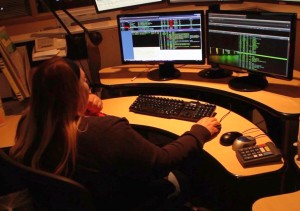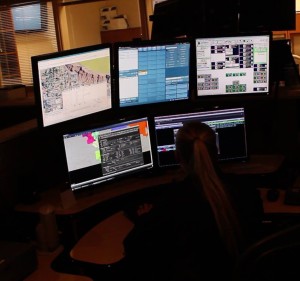
ST. GEORGE — If a Southern Utah resident requires emergency services, the phone number they call is 911. Dispatchers at the St. George Communications Center answer the call and soon one or more emergency units, be they fire, police or ambulance, are responding to the location. What is not seen is the people in the dispatch center taking those calls and coordinating the emergency responders to provide coverage for Washington County.
This is National Telecommunications Week, a week set aside to honor and recognize those in public safety that work behind the scenes in a high-stress job that requires skill, emotional control, and precision.
With 30 computers, four to five dispatchers on radios at any one time, call center staff answering 911 calls, five dedicated technical support staff and a supervisor, the dispatch center is a quiet hotbed of activity. Dimmed lights, quiet voices, and a sense of urgency permeate the room as dispatchers and phone staff coordinate to provide rapid response to both emergency and nonemergency situations throughout the county. Each station can be repurposed to dispatch any agency within seconds; so if one station goes down, the downtime will be minimized. There is also a backup center at a local fire station that can be switched to in case of complete failure or emergency.
Cindy Flowers, the dispatch center supervisor, said the center’s statistics are impressive.
“The center gets approximately 250,000 calls per year,” Flowers said. “We are sixth in the state for call volume. Our goal is to answer 90 percent of all calls within 10 seconds. We are exceeding that goal, answering 90.5 percent of calls within five seconds.”
Another statistic Flowers pointed to was the explosion of mobile phones in the area.
“Only 22 percent of the calls we receive are made from landline phones,” she said.

Each dispatcher is assigned different positions in the center every day. One day a dispatcher may be dispatching police, the next day fire, and the next day answering 911 calls, Assistant Communications Manager Justin Grenier said. Dispatchers work an eight-hour day in three shifts.
Training for a dispatcher is intense. Dispatch Training Supervisor Heather Hallman said all dispatchers must be certified by the Peace Officers Standards and Training organization, and undergo over 850 hours of training. Additionally, a dispatcher must obtain 20 hours a year in continuing education credits to keep their certification.
The Utah Communications Authority is the agency that handles the installation and upkeep of the statewide radio system. UCA began life as the Utah Communications Area Network, or UCAN. The goal was to bring seamless coverage to the state, and link the systems so if a unit needed to talk from Salt Lake City to St. George, for instance, it could be accomplished with very little effort.

The initial effort was met with some resistance, as many local organizations were reluctant to abandon their old radio systems. But as more cities signed on to UCAN, the word spread about how robust and convenient the system is, and more cities began the switch-over. St. George and Washington made the switch in 2011 and assigned their former channels to other city departments.
The public is also affected by this change. It used to be that you could buy a $99 scanner and listen to all the locals, police, fire, et cetera. Since the system change, a scanner capable of following an 800 MHz trunked radio system must be used — specifically a Motorola Type II system — which can be in the $300-$400 range depending on the features.
Grenier said the St. George Communications Center is providing better coverage and enhanced safety for first responders, now that systemwide improvements have been implemented. The new radio channels have been completely rolled out in Washington County, new sites have been added, and users of the system seem pleased with the coverage and reliability of the Utah Communications Authority system. Grenier, who is also a board member of UCA, praised the new system.
“It’s head and shoulders better than what we had.”
Related posts
- County Commission: Big year for search and rescue, 911 dispatch
- City approves ambulance ordinance, dispatch agreement
- News short: OnStar alerts dispatch when man veers off road
- Public invited to open house for new dispatch training center; STGnews Videocast
- Ambulance war scapegoat? St. George Dispatch responds to hearing testimony
Email: [email protected]
Twitter: @STGnews | @NewsWayman
Copyright St. George News, SaintGeorgeUtah.com LLC, 2015, all rights reserved.
This is a difficult job I would not want to take on. Speaking of heroes, I’m glad these heroes in the back ground finally got some kudos. By the say, there is an app for that…scanners, I mean. I can listen to all of Washington County dispatch on my cell phone for free.